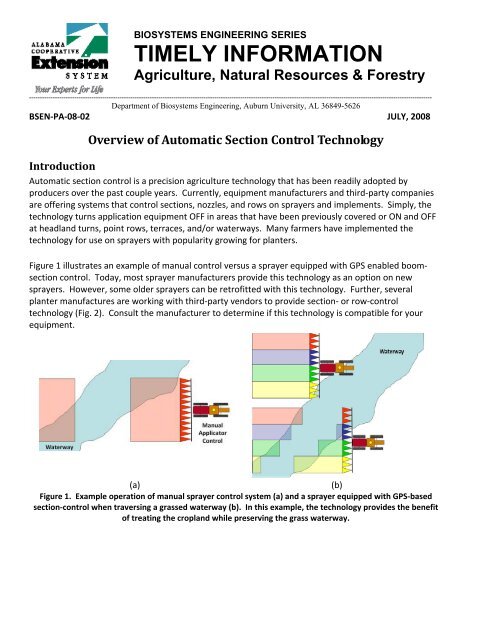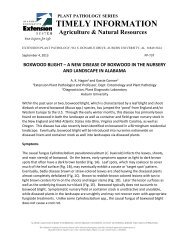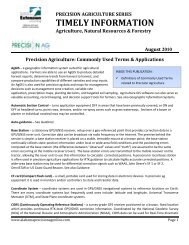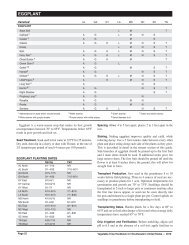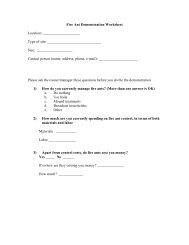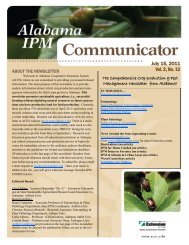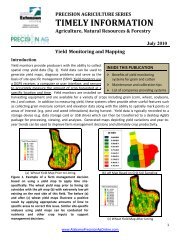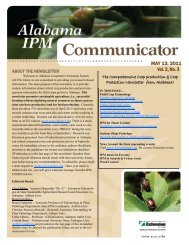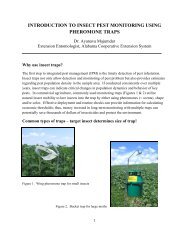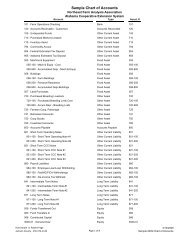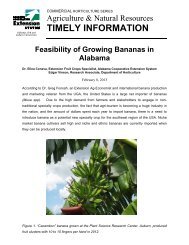Overview of Automatic Section Control Technology - Alabama ...
Overview of Automatic Section Control Technology - Alabama ...
Overview of Automatic Section Control Technology - Alabama ...
Create successful ePaper yourself
Turn your PDF publications into a flip-book with our unique Google optimized e-Paper software.
BIOSYSTEMS ENGINEERING SERIES<br />
TIMELY INFORMATION<br />
Agriculture, Natural Resources & Forestry<br />
-------------------------------------------------------------------------------------------------------------------------------------------------------------------------------------------<br />
Department <strong>of</strong> Biosystems Engineering, Auburn University, AL 36849-5626<br />
BSEN‐PA‐08‐02 JULY, 2008<br />
<strong>Overview</strong> <strong>of</strong> <strong>Automatic</strong> <strong>Section</strong> <strong>Control</strong> <strong>Technology</strong><br />
Introduction<br />
<strong>Automatic</strong> section control is a precision agriculture technology that has been readily adopted by<br />
producers over the past couple years. Currently, equipment manufacturers and third‐party companies<br />
are <strong>of</strong>fering systems that control sections, nozzles, and rows on sprayers and implements. Simply, the<br />
technology turns application equipment OFF in areas that have been previously covered or ON and OFF<br />
at headland turns, point rows, terraces, and/or waterways. Many farmers have implemented the<br />
technology for use on sprayers with popularity growing for planters.<br />
Figure 1 illustrates an example <strong>of</strong> manual control versus a sprayer equipped with GPS enabled boomsection<br />
control. Today, most sprayer manufacturers provide this technology as an option on new<br />
sprayers. However, some older sprayers can be retr<strong>of</strong>itted with this technology. Further, several<br />
planter manufactures are working with third‐party vendors to provide section‐ or row‐control<br />
technology (Fig. 2). Consult the manufacturer to determine if this technology is compatible for your<br />
equipment.<br />
(a)<br />
(b)<br />
Figure 1. Example operation <strong>of</strong> manual sprayer control system (a) and a sprayer equipped with GPS‐based<br />
section‐control when traversing a grassed waterway (b). In this example, the technology provides the benefit<br />
<strong>of</strong> treating the cropland while preserving the grass waterway.
Components<br />
The cost for this technology generally starts around $2000 but depends upon existing technology and<br />
equipment you may already be using on your farm. At minimum, you must have a:<br />
• GPS receiver<br />
• <strong>Control</strong>ler with s<strong>of</strong>tware capable <strong>of</strong> automatic section/row control<br />
• Proper boom valves for sprayers or row clutches for planters<br />
Other components can include a flow meter/control or other sensors to maintain the desired application<br />
rate when turning rows or sections ON/OFF. Please consult manufacturers for the necessary<br />
components and cables.<br />
Benefits<br />
Our calculations have shown input savings from 5% to over 30% for each pass across a field using<br />
automatic section control. However, these savings are dependent upon field shape and size with higher<br />
benefits occurring in large, irregular shaped fields or fields containing conservation management<br />
structures such as grass waterways and terraces.<br />
Benefits <strong>of</strong> this technology can include:<br />
1. Improved overall sprayer and planter accuracy<br />
2. Reduced overlap thus reducing overall input costs<br />
3. Improved environmental stewardship<br />
4. Reduced crop damage from over‐application<br />
5. Improved application efficiency<br />
6. Optimized operator efficiency<br />
Figure 2. Example benefits <strong>of</strong> planter individual row control to reduce overlap and skipped areas. The<br />
technology improves planting efficiency while savings on the amount <strong>of</strong> planted seed.<br />
Utilizing a guidance system in conjunction with automatic section control, can significantly improve<br />
field efficiency while providing input savings. Generally, automatic section control technology can pay<br />
for itself over 1 to 2 growing seasons.<br />
Prepared by<br />
Daniel Mullenix, Research Engineer, John Fulton, Assistant Pr<strong>of</strong>essor, Christian Brodbeck, Research<br />
Engineer Biosystems Engineering Department, Auburn University and Amy Winstead and Shannon<br />
Norwood, <strong>Alabama</strong> Cooperative Extension System.<br />
ALABAMA A&M AND AUBURN UINVERSITIES, AND TUSKEGEE UNIVERSITY, COUNTY GOVERNING BODIES AND USDA COOPERATING<br />
The <strong>Alabama</strong> Cooperative Extension System <strong>of</strong>fers educational programs, materials, and equal opportunity employment<br />
to all people without regard to race, color, national origin, religion, sex, age, veteran status, or disability.<br />
2
Available Systems and <strong>Technology</strong><br />
The following table provides a partial list <strong>of</strong> companies either providing complete systems or technology<br />
for these systems (last updated July 2008). Mention <strong>of</strong> trade names and commercial products is for<br />
informational purposes and does not necessarily imply endorsement by Auburn University or the<br />
<strong>Alabama</strong> Cooperative Extension System.<br />
Company System Name No. <strong>of</strong> <strong>Section</strong> <strong>Control</strong>s Website<br />
Topcon X20 Auto‐<strong>Section</strong> <strong>Control</strong> Up to 30 1<br />
John Deere Swath <strong>Control</strong> Pro TM Up to 12 2<br />
Relevant <strong>Control</strong>ler<br />
GreenStar TM 2 (GS2)<br />
Raven AccuBoom (CAN) Up to 10 3<br />
AccuBoom (Parallel) Up to 7 3<br />
SmartBoom Up to 7 3<br />
Relevant <strong>Control</strong>lers<br />
SCS 330 Up to 3<br />
SCS 400 Series 3, 6, or 7<br />
SCS 600 Series Up to 7<br />
SCS 4000 Series Up to 10<br />
TeeJet / Mid‐Tech Swath Manager Up to 5 4<br />
Boom Pilot Up to 15 4<br />
Centerline® 230BP Up to 15 4<br />
Relevant <strong>Control</strong>lers<br />
Legacy 6000<br />
ARC‐TASC Series Rate <strong>Control</strong>lers<br />
844 and 854 Rate <strong>Control</strong>lers<br />
Trimble AgGPS® EZ‐Boom TM Up to 10 5<br />
AgLeader <strong>Technology</strong> EZ‐Boom TM Up to 10 6<br />
AutoSwath TM Up to 10 6<br />
Relevant <strong>Control</strong>lers<br />
Insight<br />
SeedCommand<br />
DirectCommand<br />
Farmscan Farmlap ABS 5210 up to 10 7<br />
Farmlap Spray <strong>Control</strong> with Auto Boom<br />
Switching<br />
Up to 14 7<br />
Canlink 3500 Spray Guidance with TWIN<br />
Spray Line <strong>Control</strong><br />
5, 7, or 9 7<br />
Rinex AutoSPRAY AS7500 Up to 32 8<br />
Tru‐Count Air Clutch 9<br />
Capstan PWM Individual Nozzle Solenoids 10<br />
Related Websites<br />
1 www.topconpositioning.com 4 www.teejet.com or www.mid‐tech.com 7 www.farmscan.net 10 www.capstanag.com<br />
2 www.deere.com 5 www.trimble.com 8 www.rinex.com<br />
3 www.ravenprecision.com 6 www.agleader.com 9 www.trucount.com<br />
3


